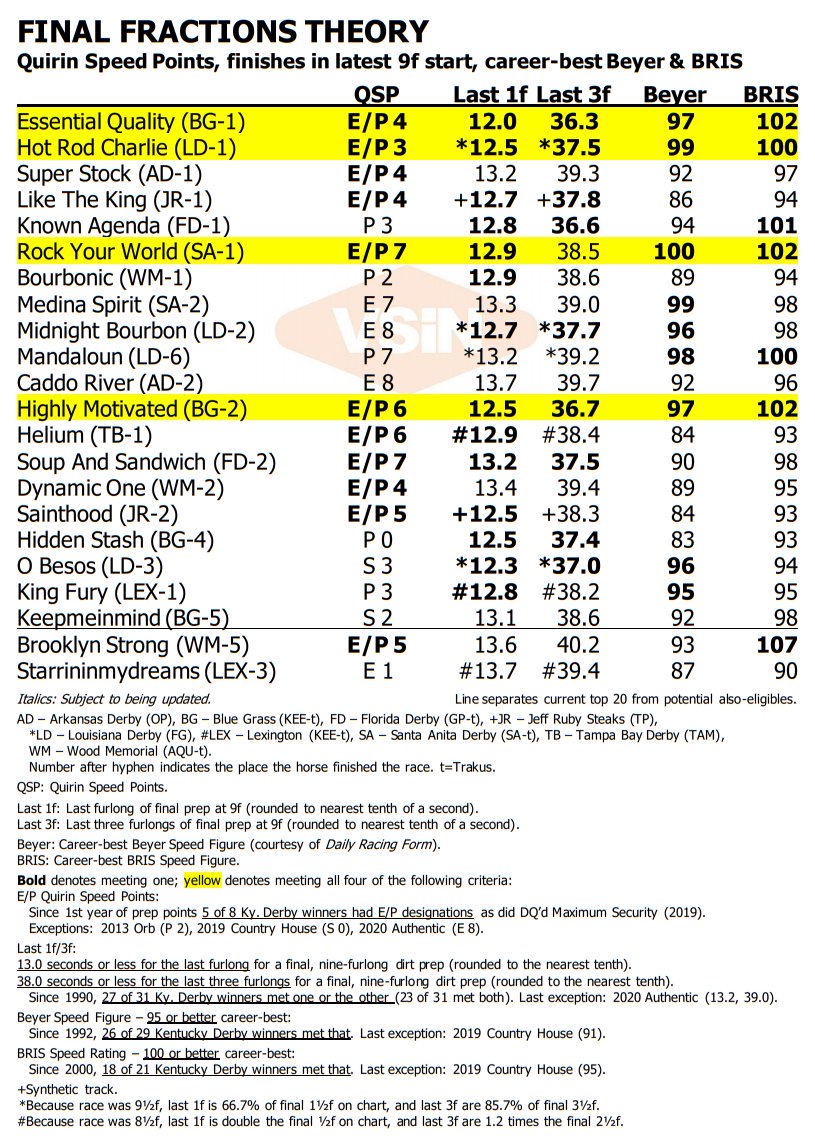It’s Kentucky Derby Week. Entries are taken tomorrow followed by post position draw. Then handicapping and prognosticating begins in earnest. The field of 20 needs to be culled. Everyone has a method to get to a contender group and some can convince themselves that only one outcome is possible.
A method used by Canterbury analyst and year-round horse gambler Brian Arrigoni to find contenders and dump pretenders is the Final Fractions Theory which looks at the final quarter-mile and three-quarter-mile fractional times of the Derby contenders’ most recent prep race.
“I’m typically skeptical of ‘theories’ or algorithms, but for as long as I’ve followed [Final Fractions Theory] it has consistently produced results and assisted in eliminating horses I thought had a big chance,” Arrigoni said.
Final Fractions Theory was popularized and named by Jennie Rees, long-time reporter for the Louisville Courier-Journal who now is a communications specialist in Kentucky. “I can’t even tell you how long ago but probably at least 25 years,” Rees said.
Rees is a five-time Eclipse Award winner and 2014 inductee into the National Museum of Racing and Hall of Fame’s Joe Hirsch Media Roll of Honor. She’s married to Kentucky trainer Pat Dupuy. Rees accompanied Dupuy to the 2010 Claiming Crown at Canterbury and chronicled the experience.
“How [the Final Fractions Theory] came about,” Rees said, “is a Kentucky trainer, Phil Thomas, one spring told me “I bet you if you look at the final quarter-mile of the Derby winners, they all came home the last quarter-mile of their final prep in under 25 seconds” or words to that effect.
“I couldn’t figure out how to compute the last quarter-mile, but you can do the last eighth- and last three-eighths from the chart – these all being for 1 1/8 mile races,” she said. “I did the calculations, taking into account how far back each horse was at that point of call to get adjusted splits, and sure enough, there was a real pattern. The big value is in eliminating some favorites and also identifying some big-price horses worth using in the gimmicks. Giacomo was a prime example.”
Eliminating horses is as important as identifying those capable of winning. Using the theory, Arrigoni found that “Irish War Cry was a pitch” in the 2017 Derby. He was the 4.8 – 1 second choice and finished tenth in the Derby. In the 2018 Derby “Justify towered,” Arrigoni said, “and My Boy Jack, who won the Lexington Stakes, was a complete pitch at 6 to 1 odds.” Justify won that Derby enroute to a Triple Crown while My Boy Jack finished fifth and never won again in his career.
Others have embraced the theory as well.
“I will tell you that I use Ron Flatter’s calculations,” Rees said. “Ron has really taken the torch from me on this. I did write about the Final Fractions Theory for WAVE-3 TV in Louisville’s website from 2016 to 2019 after writing about it for years for The Courier-Journal. I am happy to be known as popularizing the theory and I’m also happy that it has taken root. I will tell you that it was one of the two most popular features I wrote for The Courier-Journal.”
Flatter is a sports journalist and radio broadcaster working for VSiN, The Sports Betting Network. He hosts podcasts regularly. The site is a top notch resource for racing and sports bettors. Flatter has incorporated other data into the Final Fractions Theory as well.
Below is a look at Final Fractions Theory for Saturday’s Kentucky Derby posted on Twitter by Flatter. Use it to create your Derby contender/pretender list.
Follow Flatter on Twitter at @ronflatter .
Jennie Rees an also be found on Twitter at @Tracksidejennie . She provides consistent racing coverage worth following.

